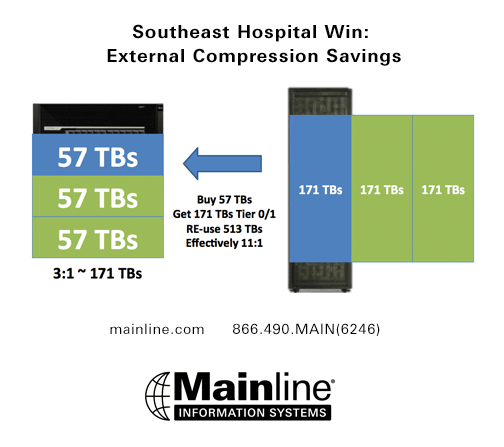“This thing really sucks!” I exclaimed.
My girlfriend isn’t amused with the pun, as we stood there listening to the lulling sounds of a canister vacuum suck the air out of the Space Bag©. As infomercials have shown us, Space Bags© are those large bags for extra linens and clothes, which we tend to over accumulate, that compress by removing the air and then occupy less space. The package claims up to 3 times more space (3:1 compression). We are, of course, doing this to make room for more stuff (arguably, that we won’t use). This is not unlike the data management storage growth problem in modern datacenters.
Nearly all storage vendors today offer some type of data reduction for their products. Whether that is archive, near-line, backup or active datasets, an appropriate solution exists. The challenge for active data has been providing a compression feature that doesn’t impact performance. All-flash arrays provide an extremely fast response time to allow data reduction in-line, without any impact to production data performance. IBM takes this a leap forward with external virtualization and compression.
The IBM FlashSystem v9000 incorporates Spectrum Virtualize, the secret sauce that allows v9000 administrators the ability to virtualize existing storage footprints, by nearly any storage vendor. Once this is implemented, seamless non-disruptive migrations of latency-sensitive workloads to the v9000 can occur, in the background, while production continues. After the workload is fully moved to the v9000, the empty space can be repurposed for other datasets AND COMPRESSED!! That’s right—the old spinning disk, that still has depreciation or maintenance or lease payments left on it, can be used for Tier2/3 workloads, and the space can be doubled or tripled using in-line compression. No other vendor has this feature available.
So, for example, with the investment of 57 TBs (full shelf) of IBM FlashSystem storage, you can effectively end up with 171 TBs of flash space and 513 TBs of reused disk space. How does that work, you ask? If you assume, on average, the compression rate of your data is 3:1, then you end up with 57 TBs * 3 (compression rate) = 171 TBs of effective space on the v9000. After you migrate, and fill up the 171 TBs, you now have the same space free on your existing storage. However, you are now free to replace that space with compressed data. Assuming the same 3:1 ratio, the 171 TBs of disk becomes 513 TBs (see graphic)!! That is, effectively, 12:1 storage capacity to purchased capacity. That’s one helluva Space Bag©.
Mainline Information Systems has System Engineers, Architects, Consultants and Service Technicians waiting to examine your environment, and make recommendations on how you can take advantage of this extremely storage efficient technology. IBM also offers a free tool called the Comprestimator to estimate your data’s compressibility. A guarantee is also available if your capacity decision is based on the results of the tool. So, spend some time and test the IBM FlashSystem v9000 external compression. Pretty soon you’ll be exclaiming, “This thing really sucks!”

